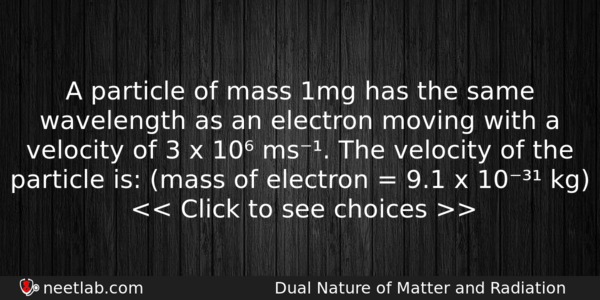| ⇦ | 
| ⇨ |
A particle of mass 1mg has the same wavelength as an electron moving with a velocity of 3 x 10⁶ ms⁻¹. The velocity of the particle is: (mass of electron = 9.1 x 10⁻³¹ kg)
Options
(a) 2.7 x 10⁻¹⁸ ms⁻¹
(b) 9 x 10⁻² ms⁻¹
(c) 3 x 10⁻³¹ ms⁻¹
(d) 2.7 x 10⁻²¹ ms⁻¹
Correct Answer:
2.7 x 10⁻²¹ ms⁻¹
Explanation:
Wavelength of particle (λ₁)
= h/mv = h / (1 x 10⁻³) x v
where v is the velocity of the particle. Wavelength of electron
(λ₂) = h / (9.1 x 10⁻³¹) x (3 x 10⁶)
But λ₁ = λ₂
h / (1 x 10⁻³) x v = h / (9.1 x 10⁻³¹) x (3 x 10⁶)
v = (9.1 x 10⁻³¹) x (3 x 10⁶) / 10⁻³
= 2.7 x 10⁻²¹ ms⁻¹
Related Questions:
- Which radiations are used in tratement of muscles ache?
- Two balls of mass m₁ and m₂ are separated from each other by powder charge
- Match the following columns about collision
- Two point white dots are 1 mm apart on a black paper.
- The mass of a lift is 2000kg. When the tension in the supporting cable is 28000N, then its acceleration is
Topics: Dual Nature of Matter and Radiation
(150)
Subject: Physics
(2479)
Important MCQs Based on Medical Entrance Examinations To Improve Your NEET Score
18000+ students are using NEETLab to improve their score. What about you?
Solve Previous Year MCQs, Mock Tests, Topicwise Practice Tests, Identify Weak Topics, Formula Flash cards and much more is available in NEETLab Android App to improve your NEET score.
Share this page with your friends

Leave a Reply